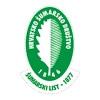
DIGITALNA ARHIVA ŠUMARSKOG LISTA
prilagođeno pretraživanje po punom tekstu
| ŠUMARSKI LIST 11-12/2003 str. 17 <-- 17 --> PDF |
J. Vukelić, D. Baričević, D. Drvenkar: FIT0CKN0L0ŠKE KARAKTERISTIKE BUKOVIH ŠUMA ... Šumarski list br. 11- 12, CXXVI! (2003), 531-544 Osnova gospodarenja za Gospodarsku jedinicu "Kal - Trinaj stić, I., 1995: Samoborsko gorje, a refuge of Javorac" 2001-2010. various floral elements between the Alps and the Pavletić, Z., I. Trinajstić, I. Sugar, 1982: Die Dinaric mountains. Acta Bot. Croat. 54: 47-72. wärmeliebenden Hopfenbuchen- Buchenwalder Vrbek, M, 2000: Ruderalna i korovna flora Žumber- (Ostryo-Fagetum Wraber) in Nordwest - Kroa- ka. Magistarski rad, Prirodoslovno-matematički tien. Studia geobotanica 2: 15-19. fakultet Sveučilišta u Zagrebu, 102 str. Šugar, I., 1972: Flora i vegetacija Samoborskog gor- Vukelić, J., D. Baričević, 2002: Novije fitoceno- ja. Doktorska disertacija, Sveučilište u Zagrebu. loške spoznaje o bukovim šumama u Hrvatskoj. Šugar, I., 1973: Dvije nove biljne zajednice u Samo- Šumarski list 126 (9-10): 439-457. borskom gorju. Acta Bot. Croat. 32: 197-202. Vukelić, J., D. Baričević, 2003: Šumske zajedni- Trinajstić, 1., 1972: Fitocenološka istraživanja bu- ce obične bukve u Hrvatskoj. Monografija Obič- kovih šuma Gorskog Kotara. Acta Bot. Croat. na bukva (Fagus sylvatica L.) u Hrvatskoj, str. 31:173-180. 87-123. Trinajstić, I., Z. Cerovečki, 1978: O cenoarealu Willner, W., 2002: Syntaxonomische Revision der crnoga graba, Ostrya carpinifolia Scop. (Coryla- südmitteleuropäischen Buchenwälder. Phytoco- ceae) u Hrvatskoj. Biosistematika 4 (1): 57-65. enologia 32 (3): 337—453. SUMMARY: The paper presents synecological-vegetational research on beech forests in Samoborsko Gorje. Phytocoenological research was conducted using the classical Braun-Blanquet method. A total of 35 phytocoenological records were taken mainly in the management unit of Kal - Javorac, and to a lesser extent in the management unit Tepee - Palačnik - Stražnik. The records were inserted into Turbo Veg Database. The phytocoenological records were analysed with classical synthetic analysis and their multivariate analysis was conducted using the Sintax 2000 statistic package. Samoborsko Gorje and Mount Zumberak form an integral mountain area in the northwest of Croatia. The plant world of Samoborsko Gorje owes its diversity to a set of factors, in the first place to the climate, then to its geographical position, the indented relief, the richness of water courses and the diversity of the geological base and soil. Beech forests are the most widely distributed forests on Samoborsko Gorje. The largest surfaces are covered by neutrophylic beech forests, while acidophilic and basophilic beech forests occur over limited, smaller areas occurring among the former. According to the results of the synthetic analysis of phytocoenological records and their multivariate statistical analysis, the area under study is inhabited by four important communities. These are Illyrian montane beech forest with deadnettle (Lamio orvalae-Fagetum sylvaticae), beech forest with hop hornbeam fOstryo-Fagetum sylvaticae), beech forest with woodrush (Tuzulo-Fagetum sylvaticae) and beech forest with hard fern (Blechno- Fagetum sylvaticae). Illyrian montane beech forest occurs on brown soil of a deeper profile, beech forest with woodrush and beech forest with hard fern on dystric cam- bisol over a silicate parent rock, and beech forest with hop hornbeam is found on rendzinas over a dolomite parent rock. The presence of Illyrian species (l^amium orvala, Primula vulgaris, Aremonia agrimonoides, Ruscus hypoglossum) confirms the affiliation of the associations Lamio orvalae-Fagetum sylvaticae and Ostryo-Fagetum sylvati- cae to the alliance Aremonio-Fagion, while the associations Luzulo-Fagetum sylvaticae and Blechno-Fagetum sylvaticae are typical Central European species that belong to the alliance Luzulo-Fagion. 543 |